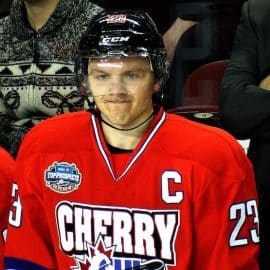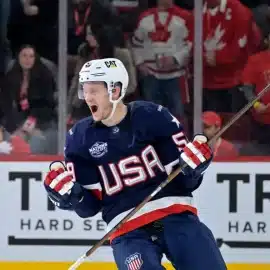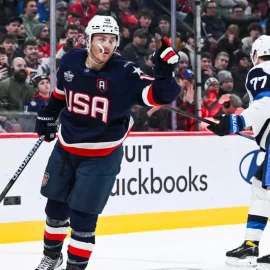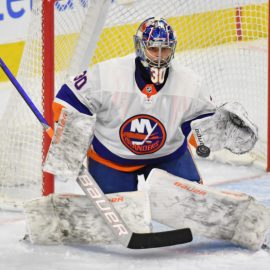After speaking to one NHL general manager, TSN‘s Frank Seravalli expanded on a thought that when it comes to the salary cap ceiling, each of the league’s 31 teams can be categorized as belonging to one of three categories: the salary cap hell bucket; the easy livin’ bucket; and the comfortable middle bucket.
The Ottawa Senators only have 28 standard player contracts on the books next season accounting for a projected salary cap hit of approximately $41.9 million, leaving the team with almost $39.6 million in projected cap space.
In 2019, Eugene Melnyk pledged to spend to the upper reaches of the salary cap ceiling from 2021 to 2025 as part of his plan to go all-in and initiate Ottawa’s five-year run of unparalleled success.
Even before the pandemic hit the team’s bottom-line, you could not blame Senators fans for being suspicious of the owner’s promises to spend. Similar promises have been made before, but this time, this pledge was made shortly after the organization’s relationships with star players frayed during the contract negotiation process.
If the organization is going to struggle to dole out cash and keep its best players then, what is going to change to ensure that it does not happen in the future with the next wave of players?
As Seravalli points out however, the Senators have a ton of financial flexibility available to them on paper and at the very least, they will have to spend some of it to clear the salary cap floor.
The Senators have impending unrestricted free agents like Matthew Peca, Ron Hainsey, Mark Borowiecki, Scott Sabourin and Craig Anderson, but Dorion already acknowledged yesterday that Anderson and Borowiecki would not be returning and they were arguably the most useful of the lot.
Signing restricted free agents like Chris Tierney, Anthony Duclair and Connor Brown will chip away at the figure needed to reach the floor, but the Senators have put themselves in a position where they will likely have to go out in free agency or trade to secure a player or a few players who can help them surpass this threshold.
Fortunately, with all of their cap space, it affords the Senators a ton of flexibility and an opportunity to exhaust every creative solution to reach the cap floor.
Like the Carolina Hurricanes acquiring Patrick Marleau last year for a first-round pick, the Senators could acquire a bad short-term contract from a team pressed up against the cap ceiling in exchange for a valuable young asset.
Conversely, the Senators could follow through on the rumours that Frank Seravalli put out in his article today:
“The Sens have more than $18 million to spend just to get to the salary cap floor ($60.2 million) and they plan to use their four second-round picks (Nos. 33, 52, 59 and either 61 or 62, depending on Dallas’ outcome in the Stanley Cup final) to help pluck players from teams in cap trouble.”
From what Seravalli has heard, it sounds like the Senators would prefer to use their draft pick capital to find players that can augment and fit well with Senators’ commitment to their young core.
Suffice it to say, without knowing ahead of time who the Senators are interested in targeting, it’s impossible to say conclusively what they should or should not do.
It may sound like a cop out, but trade analysis is completely contextual.
Who are the Senators trading for? What did they give up? How many years left are on the deal? Or, how long is a player under control for?
All of these questions matter, but if warning bells are going off, it is not without a reason.
Stanley Cup contenders are not exactly renowned for being anxious to move young and emerging talent simply to cut costs, but that does not mean that it does not happen. As some Twitter followers have rightfully pointed out, the Chicago Blackhawks have moved young talents like Teuvo Teravainen and Artemi Panarin.
In the case of Teravainen, the Blackhawks were so anxious to dump the two years and $9 million remaining on Brian Bickell’s contract that they included the 2012 first-round pick in the deal in exchange for Carolina’s 2016 second-round pick and a 2017 third.
In 2017, the Blackhawks dealt Panarin, but it was not really a salary dump as much as it was a hockey deal to reunite the team with former Blackhawk Brandon Saad. The Jackets sent Saad and a 2018 fifth-rounder to Chicago for Panarin, Tyler Motte and a 2017 sixth-round pick. After Panarin signed an extension in Columbus, the monetary difference between the two parties in this deal was a wash.
Good players can obviously be had, but teams typically aren’t just looking to give these players away.
Looking at Dorion’s trade history, it’s quite obvious that his best deals have occurred when the organization was a seller looking to dump talent and money while acquiring as many future assets as it could.
Not surprisingly, his worst deals have often come when the team was aggressively trying to make a splash or improve the short-term outlook of his team.
If Dorion is sincere about trying to improve the team’s competitiveness now, it is going to be fascinating to watch him transition from his complete teardown of the Senators’ roster to actually taking steps to make sure the team is better on the ice.
The easiest part of the job is done and all eyes are going to be on him moving forward. He essentially has a blank slate to work with, but with all the cap space, a deep farm system and significant draft capital to work with, there shouldn’t be any excuses.
The pressure is only going to ramp up from here.
Add The Sports Daily to your Google News Feed!






